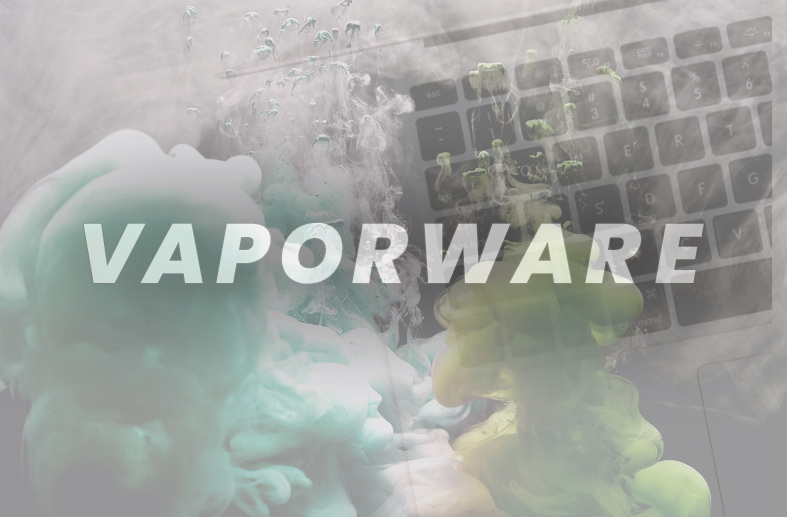What is Vaporware? And How to Find Out if It’s What You’re Being Sold

Nathan Turner
"If it sounds too good to be true, it probably is."
You’ve found the perfect software solution for your institution. It does everything (and more) and solves your problems. But does it?
It could be vaporware.
Vaporware is something that I learned about when I was Director of Admissions at Robert Morris University. I was the ‘gatekeeper’ for all software vendor calls that, in higher ed, are all too familiar. ‘Gatekeeper’ wasn’t my favorite part of the job, but I certainly learned a lot about evaluating software.
The software buying process is stressful and can require buy-in from a large group and approvals that go all the way to the Provost’s (or President’s) office. The last thing I wanted to do - pick something that didn’t fit our needs or was vaporware.
By the end of this article, you’ll know exactly what is vaporware, how it came to be, and how to sniff it out during the buying process.
What is Vaporware?
Vaporware is hardware or software that is announced but has not been produced and may never be released.
It implies that the product (ware) is all in smoke (vapor).
Vaporware is a word that has been used in the tech industry for years. As legend has it, the origins of vaporware go back to 1982 at a company called Microsoft.
During a meeting between Ann Winblad, President of Open Systems Accounting Software, and the Microsoft executive team, she asked if they were really developing a piece of Unix software for her company. When the executives stonewalled, Winblad asked two Microsoft engineers who were working on the project. They told her that the project was ‘vaporware’ – the project simply ran out of steam.1
The word gained notoriety after Esther Dyson used it in the November 1983 issue of RELease 1.0. Since then, vaporware has become part of the tech nomenclature, opening it up to being the subject of many articles, listicles, and awards.
Keep reading below to find out how to make sure you’re not being sold vaporware!
Why vaporware exists
Vaporware is created to stave off competition and to avoid customer churn. It’s not always an intentional marketing strategy, although that’s up for debate.
Many times, vaporware is born out of fear of losing out to a competitor. It is a preemptive strike or warning signal to a competitor that software is in development so back off, please. That preemptive strike works with current customers too. If they hear the software is in development, then they won’t look for another solution.
In some cases, vaporware is nothing more than a miscommunication, and that’s why it is important to know how to spot it.
How to know if you’re being sold vaporware
Now that you know what it is, how do you know if the software you’re thinking about purchasing for your institution is vaporware or the real thing? Here are a few tips:
1. Do your due diligence
While we all want a magic wand to make our problems go away, that’s not the reality. If this new, shiny product solves your problems and more, dig deeper. Do your due diligence by researching the software and the vendor. How trustworthy is the vendor? Do they have any referenceable customers? How long has the vendor been promising this software? Do they have experience with higher ed?
Take time to review case studies or reviews about the software to learn what customers are saying about the software and the company.
One of the best things I did to research new vendors was to reach out to contacts in my network. Higher education is a small world, and that makes it easier to find a contact who is familiar with the vendor. Most vendors will provide you with a list of client schools or post them on their websites. I would look at this list to find a school where I knew someone, then reach out to collect honest, unfiltered feedback.
During your due diligence, you may learn that people have been waiting for months (or years) for the miracle software. While higher ed moves at a glacial pace, you may want the software now. Those delays are a strong indicator that the product or feature is vaporware.
2. Ask questions
If you are in the buying process and a bit skeptical? Ask questions. Ask a lot of questions.
The vendor should welcome these questions and be prepared with responses and resources to backup their claims.
These are a few questions to ask when evaluating software or other tech solutions (this list is not all inclusive):
- How long has the product been in development?
- What version are you on?
- Who else uses the product? If no one is using the product, why not?
- Does the company have a good track record?
- How frequent are product releases?
3. The Product, Itself
When you start your software buying process, put together a list of requirements and features that you want in the software, if you haven’t already. You can share the list with the vendor as part of the process.
If the vendor comes back and suddenly can deliver on every feature; buyer beware!
Pay attention to the sales pitch. Has it changed since your initial conversation? Are new features that meet your specific needs suddenly part of the pitch? Is the pitch full of jargon? These are signs that the product could be vaporware.
The true sniff test for vaporware is a live demo or free trial. Both offer the chance to see the software, the existing software, and how it works. It’s important that you see what you’re getting before you make a purchase. If no live demo or free trial exist, ask why. The answer is likely vaporware.
There are many software products available for higher ed. Some do amazing things and will help you solve problems. Others, while sounding like they can do it all, may just be vaporware.
Source:
1 http://public.kenan-flagler.unc.edu/faculty/bayusb/webpage/papers/Vaporware%28Proofs%29.pdf

Nathan Turner



